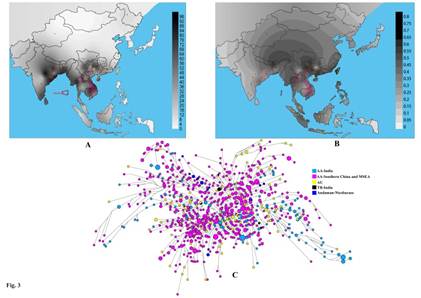Austro-Asiatic (AA) language has a somewhat unique geographic distribution, with a wide distribution not only in southern China and Southeast Asia, but also in India. AA is the eighth largest language family in the world in terms of population size (104 millions) with two major branches: Munda in eastern, northeastern and central India and Mon-Khmer, which stretches from northeastern India to the Andaman-Nicobar islands, Malay Peninsula and vast Mekong delta in Mainland Southeast Asia (MSEA) and southern China. AA is the first language of many ethnic groups in Cambodia, Vietnam, Laos, Thailand, Burma and Malaysia, and serves as the main official language in Cambodia and Vietnam.
Taking these realities into account, decades of research has resulted in long-standing debate about the geographic origin and prehistoric migratory route of AA-speaking populations. Analysis of genetic data to characterize the origin and migration history of AA-speaking populations has led to two rival hypotheses: One advocates the migratory route of the AA speakers begin in Southeast Asia and then move to India, while another one supports it an Indian origin followed by a dispersal to Southeast Asia, possibly before the Last Glacial Maximum.
Despite many previous studies on AA speakers, AA populations from MSEA and southern China continue to be under-sampled and represented. For dissecting these hot issues, we collected samples of 21 AA-speaking populations from Cambodia, Thailand and southern China (totally, 646 males). Our analysis showed that the O2a1-M95 lineage initially originated in the southern part of eastern Asia among the Daic-speaking populations around 20-40 KYA, followed by a southward dispersal to the heartland of MSEA ~16 KYA, and then a westward migration to India ~ 10 KYA. Furthermore, analysis of more than 20,000 mtDNA sequences, including these AA populations and other Asian populations, demonstrated that the maternal lineage has a different pattern from the Y-chromosome for these AA populations, supporting the proposed sex-biased admixture of the AA immigrants with local people in the Indian subcontinent. This study is published on “Scientific Reports” (http://www.nature.com/articles/srep15486) recently.
This study was supported by the National 973 Program of China, the National Natural Science Foundation of China and the Natural Science Foundation of Yunnan Province.

Figure Legend: Frequency distribution, Uh diversity and phylogenetic structure of the O2a1-M95 lineages among Asian populations. Contour map shows the frequency (A) and Y-STRs Uh diversity (B) of lineage O2a1-M95 in Asia. Colored dots indicate the geographic locations of the analysed populations that correspond with Figure 1; Bars indicate the frequency and Uh diversity spectrum respectively. C: Phylogenetic network of Y-STRs haplotypes among O2a1-M95 populations generated from the following 14 Y-STRs: DYS19, DYS389 I, DYS389Ⅱ, DYS390, DYS391, DYS392, DYS393, DYS437, DYS438, DYS439, DYS448, DYS458, DYS635 and GATA H4; Circles size is proportional to the number of samples.
Contacts:
Dr. Xiaoming ZHANG, Associate Professor
Comparative Genomic Group, State Key Laboratory of Genetic Resources and Evolution, Kunming Institute of Zoology, Chinese Academy of Sciences
Address: No.32, Eastern Jiaochang Rd, Kunming 650223, Yunnan Province, China.
E-mail: zhangxiaoming@mail.kiz.ac.cn
Phone: 086-0871-65120202
